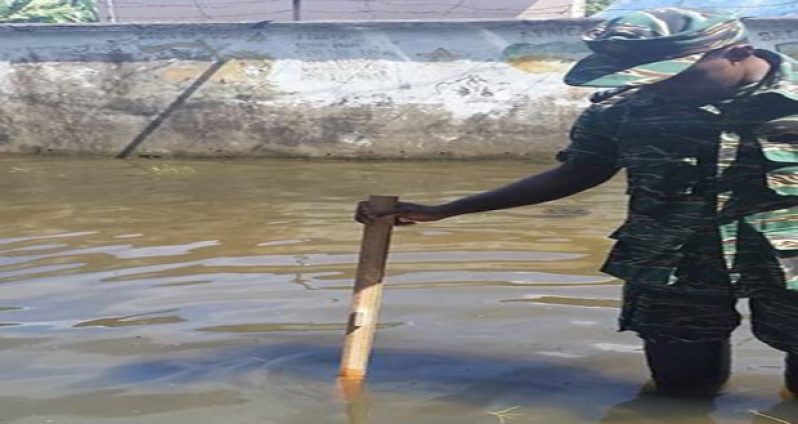WITH the recent flood, the community of Albouystown was the hardest hit in Region 4 (Demerara-Mahaica) as the Civil Defence Commission (CDC) and Government agencies continue to render assistance by providing shelter and basic necessities to its residents. Director-General of the CDC, Colonel (Rtd) Chabilall Ramsarup, made this disclosure at the post-Cabinet press briefing yesterday at Ministry of the Presidency. The retired colonel said the Commission was forced to build a shelter in the Albouystown community where assistance can be urgently delivered to residents.
The shelter was built soon after the flood to accommodate residents who are severely affected and for the delivery of food items and clothing. Residents receive three hot meals a day, along with items of clothing, compliments of the Food For The Poor.
Residents are in a better state now that the floodwater has largely receded. Ramsarup said. He however, stated that the shelter will eventually be closed once the situation remains under control as residents will be sent home and equipped with cleaning supplies and hygiene kits.
“We are still monitoring the situation as we are still not clear whether we will have any deluge, but the country is expected to see more rainfall in the next coming days,” Ramsarup said.
Apart from the Albouystown community, Ogle and Buxton on the East Coast of Demerara, as well as Region 3 (Essequibo Islands-West Demerara), have recorded acres of cash-crop losses. This was according to reports garnered by the National Agricultural Research and Extension Institute (NAREI), said Ramsarup.
Additionally, the Guyana Livestock Development Authority (GLDA) has reported some amount of cattle deaths and poultry loss in the same areas. The farmers were however, provided with assistance from the CDC and other flood-relief agencies.
Further, several businesses affected by the flood have been calling for financial aid. In this regard, Patterson said the Government is currently doing what it can to assist communities and citizens as a whole. As such, it cannot “offset” claims for businesses given that their insurance policies could cover their losses.
The flood has also caused the erosion of roads, especially in undeveloped areas. Therefore, Minister of Public Infrastructure, David Patterson, when questioned by media operatives about this, said that thus far the ministry has been working with a “systematic” plan to repair roads affected by the flood.
“Patchwork will continue throughout the rainy season, until we run into a prolonged dry season,” declared the minister.
The rehabilitation of roads is high on the ministry’s agenda, said Patterson. As such, the minister has proposed a substantial allocation for road repairs in the budget, come August. Emphasising the fact that residents of numerous communities have long been calling for new roads, Patterson said with this budget he will seek to fulfil the needs of those communities.
Given the recent Task Force that was set up to assess flood-related issues in Georgetown, Government will soon modify that Task Force to a country-wide one that will assess flood -related issues in every region.
Patterson said the task force has been proposed and will be established in due course. The unit will be headed by Retired Major General Joe Singh and will comprise several officials such as representatives from the CDC, the Private Sector Commission (PSC) as well as several ministries.
“They will be going into every region and assess what is needed,” said Patterson.
Regional officers will then be able to interact directly with the unit and will have opportunities to make presentations. The Ministry of Foreign Affairs has been offered assistance by The Netherlands, which will be sending a technical team to Guyana to assess the work of the modified Task Force.
A preliminary report however is expected to be completed in the next six months by the current unit’s resource team, which will be presented to the members that are assigned to the new Task Force. The establishment of this new Task Force will aim to provide a long-term approach for handling future floods in Guyana.
By Shivanie Sugrim



.jpg)









